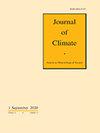南印度洋温带海表温度对南部春季南极海冰的影响
IF 4.8
2区 地球科学
Q1 METEOROLOGY & ATMOSPHERIC SCIENCES
引用次数: 0
摘要
摘要本研究探讨了南极海冰浓度(SIC)季节性变率与温带南印度洋(SIO)海表温度(SST)的关系。研究发现,南极SIO、罗斯海和威德尔海宽波段的SIC与南方春季SIO偶极子(SIOD)海温年际异常显著相关。这种关系与El Niño-Southern涛动、印度洋偶极子和南半球环状模的影响是线性无关的。SIOD的正相位,伴随着西澳大利亚附近温暖的海温异常和高纬度地区以60°E为中心的寒冷海温异常,刺激了一个下游波列,在SIO和罗斯海和威德尔海上空诱发了大规模的气旋环流。随后,异常水平水汽平流引起水汽辐散,改变了地表能量收支,使下伏海洋变冷,导致SIO、罗斯海和威德尔海区域SIC升高。该SIOD海温异常在2016年南春达到历史新低,促进了高纬度地区波浪型的突出,导致2016年春季海冰急剧减少。此外,还量化了南春季SIC趋势与SIOD海温趋势线性一致的比例。结果表明,SIOD海温趋势可能是罗斯海1979-2014年SIC趋势的重要组成部分,一致性达到60%。本文章由计算机程序翻译,如有差异,请以英文原文为准。
Impact of Sea Surface Temperature in the Extratropical Southern Indian Ocean on Antarctic Sea Ice in Austral Spring
Abstract The relationship between the seasonal Antarctic sea ice concentration (SIC) variability and the extratropical southern Indian Ocean (SIO) sea surface temperature (SST) is explored in this study. It is found that the Antarctic SIC in a wide band of the SIO, Ross Sea, and Weddell Sea is significantly related to an SIO dipole (SIOD) SST anomaly on the interannual time scale during austral spring. This relationship is linearly independent of the effects of El Niño–Southern Oscillation, the Indian Ocean dipole, and the Southern Hemisphere annular mode. The positive phase of the SIOD, with warm SST anomalies off of western Australia and cold SST anomalies centered around 60°E in high latitudes, stimulates a downstream wave train that induces large-scale cyclonic circulations over the SIO and the Ross and Weddell Seas. Subsequently, anomalous horizontal moisture advection causes water vapor divergence, changes the surface energy budget, and cools the underlying ocean, which leads to the increased SIC over the region in the SIO, Ross Sea, and Weddell Sea. This SIOD SST anomaly reached a record low during the austral spring of 2016 and promoted the prominent wave pattern at high latitudes, contributing to the dramatic decline of sea ice in the 2016 spring. In addition, the proportion of the SIC trend that is linearly congruent with the SIOD SST trend during austral spring is quantified. The results indicate that the trend in the SIOD SST may account for a significant component of the 1979–2014 SIC trend in the Ross Sea with the congruency peaking at 60%.
求助全文
通过发布文献求助,成功后即可免费获取论文全文。
去求助
来源期刊

Journal of Climate
地学-气象与大气科学
CiteScore
9.30
自引率
14.30%
发文量
490
审稿时长
7.5 months
期刊介绍:
The Journal of Climate (JCLI) (ISSN: 0894-8755; eISSN: 1520-0442) publishes research that advances basic understanding of the dynamics and physics of the climate system on large spatial scales, including variability of the atmosphere, oceans, land surface, and cryosphere; past, present, and projected future changes in the climate system; and climate simulation and prediction.
 求助内容:
求助内容: 应助结果提醒方式:
应助结果提醒方式:


